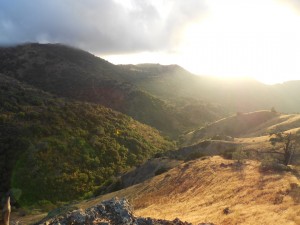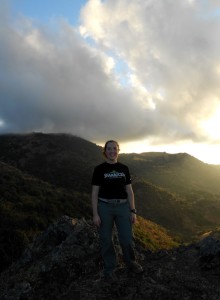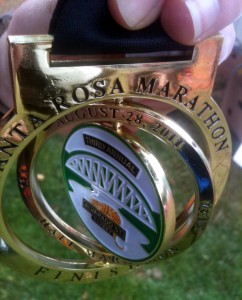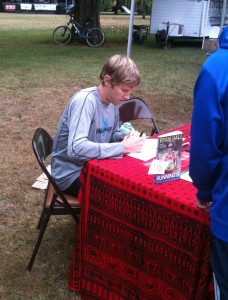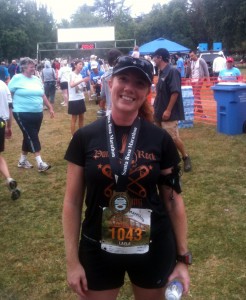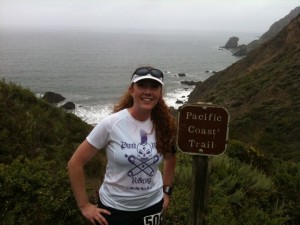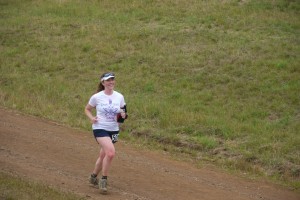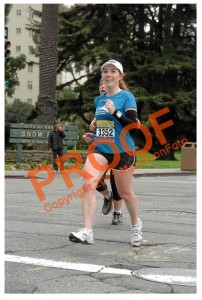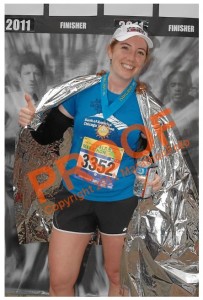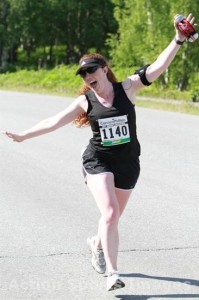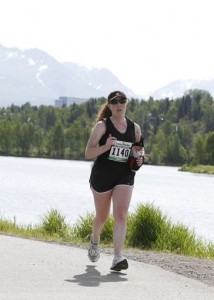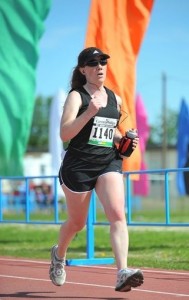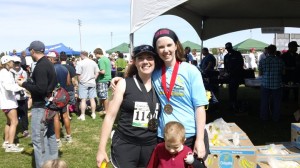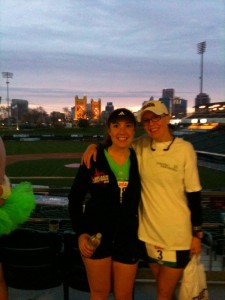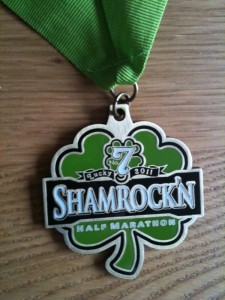After growing up in the mountains and then spending more than 13 years in a valley, it’s been pretty amazing to be back among some hills. However, though I now live just a 15-minute drive away from Mt. Diablo, I’ve only been there once — and that was by car a couple years ago before I moved.
On Sunday, I crossed that off my imaginary list of things to do. Along the way, I learned a good lesson that I need to remember during my next marathon: My head can play games with me and make me think I’m physically tired, when I’m not.
My dad came to visit this weekend, so I figured it was about time to explore Mt. Diablo on foot. On a clear day, it offers some of the most amazing views you can imagine, ranging from the Golden Gate bridge to the waters of the Delta to more mountains and valleys. It’s been very hot lately, but the weather cooled significantly on Sunday. The forecast called for rain until mid-day, so we took our time getting there (read: went to lunch, and to both REI and Sports Basement for the full nerdy fix). We drove partway up the mountain to the overlook where we were treated to this oh-so-spectacular view:
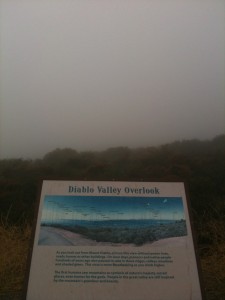
Oh well. I’d found a website that outlined a 6.6-mile hike. My knee recently went nuts for no apparent reason, so I didn’t want to overdo it. (The knee had fully recovered a couple days earlier, but only after I took more than two weeks off from running.) This seemed like a good distance, and would include the summit, which has a building with some history.
We set off down a trail, where a bunny scampered ahead of us and the pine cones were as big as my shoe.
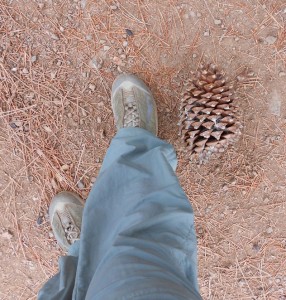
The clouds were lifting, and it was rapidly becoming ideal hiking weather. We went up and down some rolling hills, and then I came across this creature in the middle of the path:
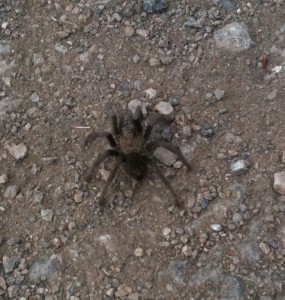
Yes, that is a tarantula. I held one when I was 10 years old, and the thing covered both of my hands then. This creature was no smaller. I couldn’t make actual words of warning come out of my mouth — it was more like, “Aaahh aaahhh aaahhhhmmmkkkkggg.” But I actually got closer to it and was about to bend down for a close photo when I had a thought: “Do tarantulas jump?!” Last summer I battled black widow spiders, and in the process I encountered a spider that Google informed me was a “jumping” spider. I hate and dread all spiders except daddy-long-legs, and the idea of a JUMPING spider gives me the shivers. So, yeah, I backed up from the tarantula. But I really wanted some perspective, so I quickly got this shot:
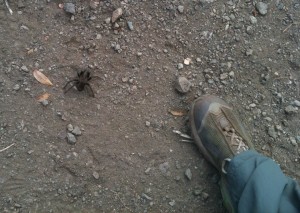
We went on our way, with me texting that picture while walking up a rather steep trail. (Yes, I had full internet/phone signal on the mountain, except the brief time when I actually needed it.) Then we turned onto a single-track trail that got even steeper. At a clearing, we were treated to this:
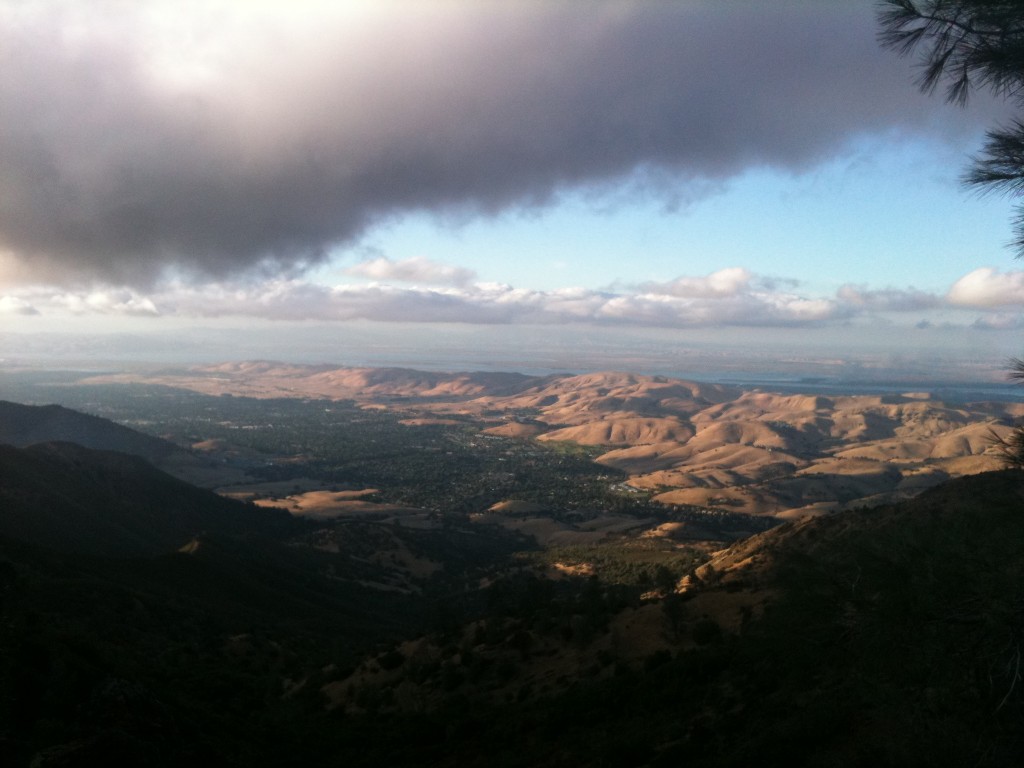
At some point, though, the trail began leading away from the summit. I’d followed the directions, I’d looked at the map on my phone, and I’d seen the summit as we circled around toward it. But I never saw a place to turn toward the Summit Trail leading to the top. That wasn’t necessarily bad, though, because the top looked pretty foggy and I think the clouds would have obstructed the view.
But then, as we took a couple pictures at that gorgeous spot, I looked at the time and realized it was 6:40 p.m. We figured the sun sets around 7:15 or 7:30. The park entrance had a sign that read, “Gates locked from sunset to 8 a.m.” At that point, I looked at my GPS watch and my phone and calculated that we had about 1.5 miles of hiking to go. Including the drive back to the gate, we’d be OK but cutting it close.
However, the 6.6-mile hike on that website hadn’t included the trail we were now hiking. And the clouds started to return, which meant things were getting darker. We hurried. At one point we ran, partly for fun and because it was downhill.
I hadn’t run on trails for a while and was just “jogging,” but then my running gait kicked in. It was such a feeling of magic — I still vividly recall the exact moment when everything suddenly became smooth and I began flying down the trail. THAT is why I run, to find that feeling of smooth euphoria where everything else slips away.
My last trail run became a death march that left a bad taste in my mouth, so this was a bit of a reminder that I do still love running trails.
But the trail seemed to go on forever, and the sky was getting darker. I looked at my phone and began counting down the tenths of a mile. And then, with 0.1 miles to go, I remembered I’d typed in an intersection that was not our endpoint. Our final destination didn’t have a good intersection that I could locate on my phone’s mapping program while I walked quickly. We actually had at least another mile left.
That realization came at the top of a hill that we’d powered up, knowing the hike was almost done. My lungs were dying, and I became completely depressed at the discovery that this hike was definitely not finished. Now I was really worrying that the park gates would be locked. I was defeated. I bent down for a minute to catch my breath and try to find my bearings. The only thing to do was to keep going and hope the rangers didn’t actually close the gates at sunset. We had water, food, a phone charger, a car and a blanket in the trunk, but no way could I handle being locked in a park until 8 a.m. I was not happy. This was definitely “the wall” of a marathon, when you want to stop and quit and call for a taxi.
I began thinking. If the gate was locked, what could I do to get out? I could jump over the gate and go look for a hacksaw, though lord knows where I’d find one. Who could I call? On a Sunday night, the park service would only be an answering machine. My first legitimate idea soon came: Earlier, when taking in the gorgeous views, I’d looked down on a town that my phone told me was Clayton. I could find their police department’s dispatch number, and they’d have a contact for the park rangers. Then my second idea came: We were in Contra Costa County; I could call a friend who works for the Contra Costa Times. He covers crime and county matters, so he’d have some phone numbers.
My spirits lifted. I had an action plan. It’s amazing how much better I suddenly felt. My lungs weren’t dying, and my legs had so much more pep in them. I even said something like, “This is what I need to do at mile 23 of my next marathon — occupy my mind by coming up with ideas of who to call to bail me out.” After 8 miles of hiking, we finally got back to the very welcome sight of my car, leaped in, and I careened gently down the winding road into the rather dark sky. (Yes, you can careen gently. It helps if you’re the only vehicle on a mountain: You can take 15 mph curves at 30 mph.)
We finally arrived at the gate. It was open. The feeling of relief that flooded through me was so strong and so sweet.
I soon realized that I’d had a couple other options, too. There are a few homes inside the park gates, and I really doubt they’d turn away a desparate, charming, slightly frazzled redheaded female. And an old friend of mine lives in Danville, another town at the foot of the mountain. I might not have his current phone number, but we’ve been emailing on facebook lately, so I could probably get hold of him.
And so my adventure on Mt. Diablo came to an end. It was a good hike and a fun time made up of gorgeous views, interesting creatures and a valuable lesson: I am usually stronger than I realize. When I came 22 seconds short of breaking four hours in a marathon this summer, that was because of my head, not my body. I still have no regrets about that amazing day, but I do know that my body could have performed a bit better if my head hadn’t said, “I’m tired; let’s give up.”
There are 14,359 seconds in a 3:59:59 marathon. The Alaska marathon took me 14,421 seconds. Rather than thinking about how tired I feel, next time the going gets tough, I need to focus on an action plan.
